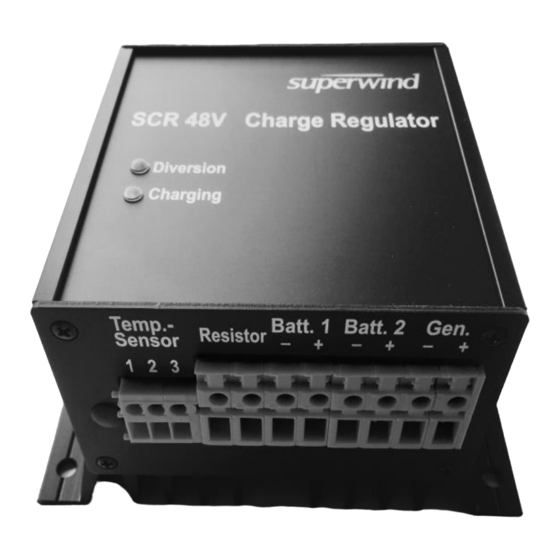
Table of Contents
Advertisement
Quick Links
Many thanks for purchasing a superwind product.
The SCR 48 V is a charge regulator of highest quality and will perfectly and reliably charge your batteries
for many years.
However, reliable operation not only will depend on the product quality but also on accurate assembling
and proper wiring. Please read this manual carefully before you start the installation. Please also keep in
mind our safety instructions and warning notices. Our main concern is with your safety.
Labelling
This manual refers to the charge regulator SCR 48 V
Manufacturer: superwind GmbH
Am Rankewerk 2 – 4
D-50321 Brühl / Germany
Tel.:
Fax.:
e-Mail:
Internet:
You will find the label with the serial number and the nominal voltage on the side of the housing.
Intended use and range of application
The SCR 48 V is designed to sense and limit the output voltage of a Superwind 350 / 48 V wind generator
and thus to prevent batteries becoming overcharged. For voltage regulation the SCR 48 V uses the
method of Pulse Width Regulation (PWM) by diverting excess power from the wind turbine to a power
resistor.
The SCR 48 V is suitable for Lead Acid Batteries, Gel Batteries, AGM Batteries (AGM = Absorbed
Glass Mat) as well as for modern LiFePO4 / LiFeMgPO4 Lithium Batteries with integrated Battery
Management System (BMS).
The SCR 48 V has two battery charging outputs isolated by Schottky blocking diodes. This allows to
charge two battery sets of the same type totally independent of each other.
Different to many other wind turbine charge regulators, the SCR 48 V receives the power for its internal
electronics from the wind turbine and not from the battery. This means that in calm periods, the SCR 48 V
does not draw any current from the battery.
The SCR 48 V is not influenced by other power sources connected to the batteries like alternators,
gensets, solar arrays and battery chargers. For that reason, it can be used very well in complex systems
and hybrid systems.
The regulator electronics are protected against humidity by a protective lacquer.
Fields of application are a wide range of industrial systems like navigational aids, traffic management
systems, environmental monitoring stations or radio transmitters. It is also used for marine applications
on buoys and ships, vehicules or mountain shelters.
Charge Regulator SCR 48 V
Manual
+49 / 2232 / 577357
+49 / 2232 / 577368
power@superwind.com
www.superwind.com
1
Advertisement
Table of Contents

Subscribe to Our Youtube Channel
Summary of Contents for Superwind SCR 48 V
- Page 1 Intended use and range of application The SCR 48 V is designed to sense and limit the output voltage of a Superwind 350 / 48 V wind generator and thus to prevent batteries becoming overcharged. For voltage regulation the SCR 48 V uses the method of Pulse Width Regulation (PWM) by diverting excess power from the wind turbine to a power resistor.
- Page 2 1 and 2. The default setting for the maximum charging voltage can be adapted to special customer requirements. Since special devices are needed, proper calibration can only be performed by the manufacturer or a superwind authorized service partner.
- Page 3 Description of functions The SCR 48 V charge regulator has been especially designed for the Superwind 350 / 48 V wind generator and guarantees optimum charging of the batteries. As long as the actual charging voltage is below the maximum charging voltage, the current from the wind turbine is directly led to the batteries.
- Page 4 In general you should mark all line ends by POSITIVE(+) and NEGATIVE (-), in order to prevent errors with the connection. Marking of the connecting cables at the Superwind 350 : POSITIVE (+) : NEGATIVE (-) : BLACK If you are not sure about the polarity of the cables from the wind generator, you can identify POSITIVE (+) and NEGATIVE (-) easily using a simple multimeter.
- Page 5 Dimensions of the charge regulator: Dimensions of the power resistor: January 2021...
Need help?
Do you have a question about the SCR 48 V and is the answer not in the manual?
Questions and answers